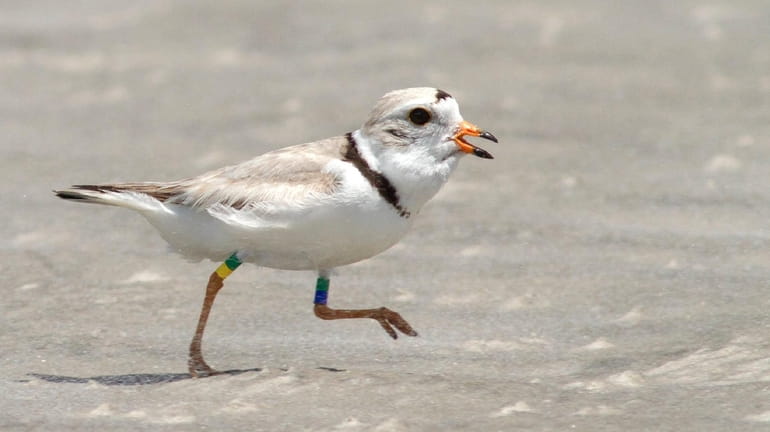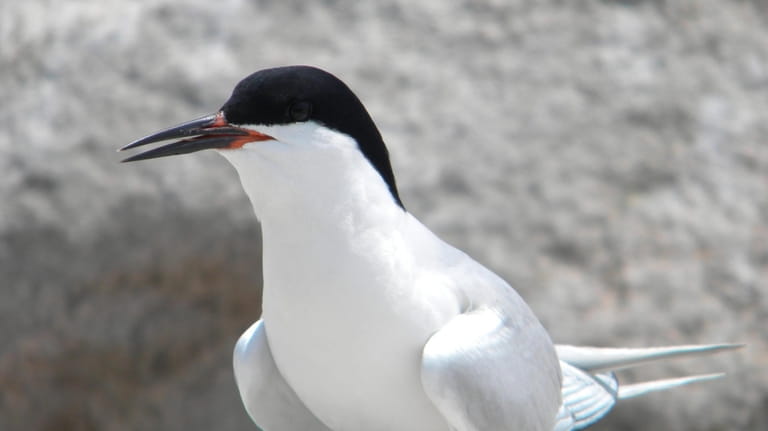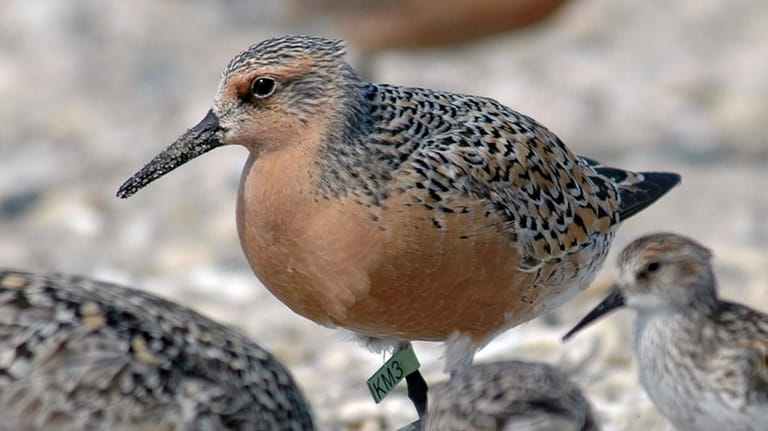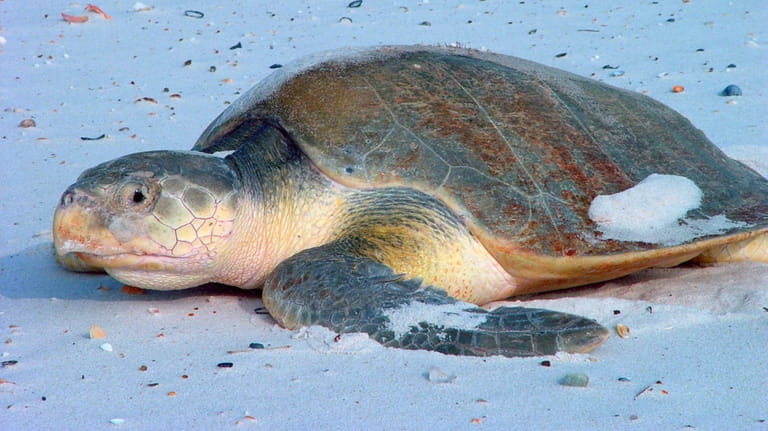Endangered Species Act turns 50: Here's what it has protected on Long Island

Fencing on Long Island beaches aim to protect piping plovers' eggs and their tiny chicks. Above, a bird banded by scientists. Credit: U.S. Fish and Wildlife Service
Every spring, makeshift fencing with bright orange ribbons strung between posts appears on Long Island beaches, designed to alert beachgoers to the presence of piping plover nests. Plovers build their nests on the ground, where they risk getting crushed by humans, dogs and cars, so the U.S. Fish and Wildlife Service erects the fences to safeguard these small shorebirds' eggs and their tiny sand-colored chicks.
“You could have 20 pair nesting on a site, but if they’re not successfully fledging, or raising any chicks to adulthood, then you are not adding to the population,” says Steve Sinkevich, a field biologist with the Fish and Wildlife Service’s Long Island field office.
But Sinkevich’s charges are in fact slowly making a comeback: Since 1992, plovers’ numbers have doubled, from about 1,000 breeding pairs to more than 2,000 pairs in 2021. And that is largely thanks to conservation efforts under the Endangered Species Act.
The Endangered Species Act was signed 50 years ago Thursday by President Richard Nixon after passing unanimously in the Senate and with four opposing votes in the House. Most conservationists agree it has been a striking success; since 1973, it has prevented the extinction of more than 99% of listed species, according to a 2019 study by the Center for Biological Diversity.
WHAT TO KNOW
- The Endangered Species Act turned 50 years old on Thursday.
- Since 1973, it has prevented the extinction of more than 99% of listed species, according to a 2019 study by the Center for Biological Diversity.
- On Long Island, the law has protected roseate terns, rufa red knots, piping plovers and several sea turtle species.
While very few species have rebounded enough to merit delisting (the study counts 39, including bald eagles and gray whales), many are slowly recovering.
Here are some of the ESA-protected species that skitter, soar and paddle along and near Long Island’s coasts.
Roseate tern colonies in Long Island Sound
More than 90% of Northeastern roseate terns belong to just three breeding colonies, and the largest of the three is on Great Gull Island in Long Island Sound, where roughly 2,000 pairs build their nests each spring.

The long tail feathers of the roseate tern were once used as accents for women’s hats. Today, the tern faces habitat loss, oil spills and other ocean pollution. Credit: U.S. Fish and Wildlife Service
Tern couples perform prolonged courting rituals involving ritualized feeding and airborne pas de deux. Once the couple produces a clutch of eggs, the nests are often attended by two (sometimes three) females, and these female co-parents may stay together for five or more breeding seasons.
Roseate terns were nearly wiped out in the late 19th century, when their long white tail feathers were used as decorations for women’s hats. Present threats include habitat loss, oil spills and other ocean pollution.
“In many cases we are causing the decline of these species, Sinkevich says. “It seems to me that we have the responsibility to try correct that.”
Rufa red knot's long migration
The rufa red knot embarks every spring and fall on one of the longest migrations in the animal kingdom, from their nesting sites in the Canadian arctic tundra to their winter habitat, as far south as Tierra del Fuego — a journey of 9,000 miles. One famous red knot lived to be 22 years old and in its lifetime flew farther than the distance from the Earth to the moon — earning the name Moonbird among ornithologists.

During their twice-yearly migrations, rufa red knots stop to rest and feed on beaches along the East Coast, including on Long Island. Credit: U.S Fish and Wildlife Service
During these twice-yearly migrations, red knots stop to rest and feed on beaches along the East Coast, including on Long Island. Overharvesting of horseshoe crabs — whose eggs are a critical food source on these refueling stopovers — is threatening red knots’ survival. Other threats include habitat loss from sea level rise, coastal development and dredging.
Beachgoers can help all these imperiled shorebirds by staying away from posted nesting areas and keeping dogs leashed, Sinkevich suggests, and by packing up all trash: Food attracts predators, and anything else can entangle birds and other wildlife. And birds that are feeding or resting should not be disturbed — they need energy to feed their chicks and prepare for their migrations.
Sea turtles on Long Island beaches
Kemp’s ridley sea turtles spend their lives at sea, coming ashore only to lay their eggs — often on the same beaches where they hatched decades earlier. They pass through New York’s waters as they migrate, but when they show up on Long Island beaches, it’s almost always because they are in distress, according to Maxine Montello, rescue program director at the New York Marine Rescue Center in Riverhead — stranded by cold-stunning, injured by a boat propeller or tangled in fishing gear.

When a Kemp's ridley turtle shows up on Long Island beaches, it’s almost always because it is in distress. Credit: U.S. Fish and Wildlife Service
In the 1940s, tens of thousands of females nested along the coast of Tamaulipas, Mexico; by the mid-1980s, there were fewer than 250 nesting females. Their numbers have increased thanks in large part to the efforts of NOAA Fisheries and international partners. A recent survey counted roughly 8,000 females.
But the Kemp’s ridleys remain critically endangered, and three other species that migrate up and down the East Coast are on the ESA list as well: the loggerhead, leatherback and Atlantic green.
“These turtles have been on our earth for about 100 million years and they play a vital role in the health of the world’s oceans,” says Carrie Upite, sea turtle recovery coordinator for NOAA’s Greater Atlantic region.
'A biodiversity crisis'
Scientists have concluded that the Earth is experiencing a sixth mass extinction, as a recent study calculated that vertebrate species have disappeared in the past century at a rate 100 times higher than the natural or “background” rate.
“We are in a biodiversity crisis — the challenges facing wildlife are only increasing,” says Erik Schneider, policy manager of the National Audubon Society. Yet conservationists working to protect endangered species face significant headwinds.
“The ESA has been starved for funding for a long time,” Schneider says. The FWS has just two field biologists covering New York City and Long Island, for example. “But we know that the ESA can work when it has sufficient funding and protections in place.”
There are other challenges. The listing process takes 12 years on average, so by the time a species is officially endangered, its numbers have sometimes fallen so far that recovery is difficult, a 2022 study in the scientific journal PLOS ONE suggested.
“We find that small population sizes at time of listing, coupled with delayed protection and insufficient funding, continue to undermine one of the world’s strongest laws for protecting biodiversity,” the authors wrote.
New listings also routinely encounter opposition from ranching, timber and other industries, and members of Congress have pushed bills that would “permanently block protections for these highly imperiled species,” Schneider says.
But conservationists are committed to protecting the Endangered Species Act in order to protect at-risk species. “The ESA has been effective,” Upite, the sea turtle expert, says. “I don’t know where we would be without it.”
